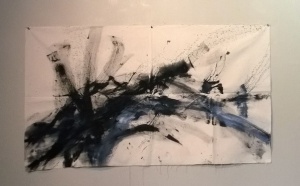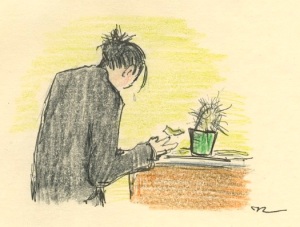I know you’re tired of it. Race. Race in America. It’s a topic ripe enough to burst, and it dominates the headlines: racial terrorism, police brutality, Obama using the “N” word. I’m sick of it too, but it’s what people of color, like me, live and breathe every day. We talk, cry, and yell it; it’s the key in which we sing.
Lately, I have been developing a body of work that deals with the fraught and beleaguered issue of race in America. These paintings are a continuation of my recent show at Seattle’s Zeitgeist Coffee, Disconnects: The Linguistics of Race. After Ferguson, I began this series as a way of processing the rage and grief that I felt.
Using a large housepaint brush, I flung acrylic paint on more than 30 feet of raw canvas. Working in such a visceral, often violent way–and on such a large scale–was cathartic for me. Although the Action Painters of the ’50s used the same methods, they produced work that was largely apolitical (and most were Caucasian men). My work is firmly rooted in the discourse of racial disparity.
The first piece in the series is Denatured, a tribute to Michael Brown.

Denatured, nailed to the wall at Zeitgeist Coffee, March 2015
Most of the other pieces use the same splatter method to represent the squandered lives that racism takes by force. The random patterns of the paint form tumultuous narratives of struggle, evoking the disemboweling of entire communities through physical and psychological violence, and the quest for liberation.
The following pieces talk about structural racism, the bias written into institutions and systems in America. From the Confederate flag flown over Southern government buildings to racial stratification in housing, vestiges of white supremacist ideology are still present in our culture.

If this reminds you of a penitentiary, then you’re on the right track.
What does experiencing racism feel like? I can say from firsthand experience that you feel eviscerated, stripped of agency, and blinded to everything except the incident itself. Your perspective distorted and self-worth negated, you feel like shit or sawdust or, worse yet, nothing at all.
But as an Asian-American, I have it easy compared to the struggles of the black community. According to writer Julia Craven, “To be black, specifically in America, is to be in a constant state of fear. There is no refuge. There is no escape. There is no sanctuary.”
Even so, you still get some wildly posturing, colonialist asshat like Rachel Dolezal, who commodifies Otherness (in the words of bell hooks) in the ultimate appropriative act of white privilege. As if race can be simply performed and adopted. As if we all had the luxury of that choice.
That’s why we have to frankly and openly address race in America—and run it ragged: understand its ins and outs, all its vagaries and gray areas. And then do something about it. From rewriting the policies and laws to subverting the dominant media narrative and its outdated tropes (see the Wall Street Journal coverage of Charleston for an example) to supporting communities of color.
This all takes thinking critically, listening carefully, and acting compassionately. Not turning the other way or pretending it’s someone else’s job. It’s our job because, goddamn it, it’s our lives and the world we live in, and there needs to be equity.







